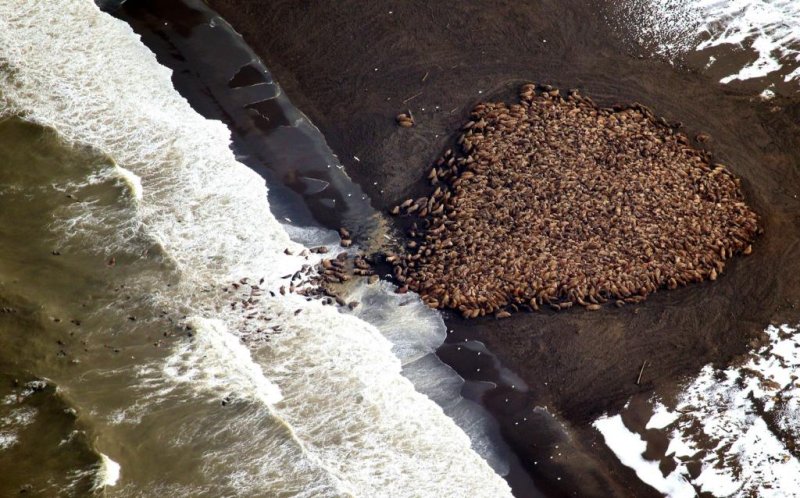1 of 4 | As sea ice declines, walruses must haul out on land more often. Photo by Corey Accardo/NOAA/NMFS
It doesn't take much to scare a walrus. The scent of a polar bear, the footsteps of a hunter or the drone of a bush plane are more than enough to send the blubbery pinnipeds into panic mode.
In past decades, when ice in the Chukchi and Bering seas was plentiful, small groups of female walruses and their pups lounged around on ice floes. At the first sign of trouble, they could easily slide into the water. But now, with long periods of open water and late summer and the extent of early fall sea ice hitting a record low, tens of thousands of walruses are hauling out along narrow stretches of the Alaska coastline, from Cape Lisburne to Point Lay to Icy Cape. Here, all it takes is one unnerved animal to trigger a deadly stampede.
At a meeting in Fairbanks, Alaska, in March, members of the U.S. Fish and Wildlife Service, the Eskimo Walrus Commission and the Federal Aviation Administration gathered in a small classroom to brainstorm measures to protect walruses against the kinds of stampede that saw thousands of the mammals killed in Russia in 2007. Last month, the FAA announced it would work with USFWS to include walrus haulout locations on navigational tools for pilots and alert them that harassing walruses is a violation of U.S. law.
Under the Marine Mammal Protection Act, it is illegal to harass a walrus. But such harassment is "broadly defined, kind of in the eye of the beholder," says Jim MacCracken, supervisor of the USFWS walrus program. Any type of human activity, including noise from nearby aircraft and boats, could be considered harassment.
The intention of the FAA's location updates is to encourage pilots to take alternate routes and travel at higher altitudes when possible, including passing inland or seaward if and when they would otherwise pass near a haulout site. But the FAA will not enact mandatory flight restrictions for wildlife unless an animal poses a safety threat to the plane, which leaves wildlife managers with few options. "FAA's main mission is aviation safety – protecting aircraft and passengers," says Jacki Holzman, its special programs integrator for Alaska.
However, last August, when 35,000 walruses hauled out around Point Lay, a narrow barrier island off Alaska's northwest coast, the FAA did establish voluntary flight restrictions between mid-August and mid-October, requesting that all planes – most of which were delivering supplies or ferrying hunters – stay half a mile away from haulouts when possible, or maintain a minimum altitude of 2,000 feet. Pilots of helicopters, which have a louder drone, were asked to stay 1 nautical mile away or 3,000 feet above ground. The voluntary restrictions were a success, says James Tazruk, a volunteer with the walrus program in Point Lay, and no stampedes were reported.
As summer and fall sea ice continues to decrease, walruses are not always hauling out in a predictable pattern, making accurate, up-to-date charts for pilots all the more important.
In late April 2016, more than 3,000 bulls hauled out along Alaska's Cape Greig – a spot where they had never been seen before. In June, the USFWS issued a news alert reminding pilots and locals to stay away from the haulout.
On top of that, local people and wildlife managers are increasingly concerned about threats of noise coming from the sea. Last summer, residents around Point Lay were agitated by a large ship from Prudhoe Bay that passed by the walrus haulout twice. Though guidelines dictate ships stay between 0.5 and 3 nautical miles away from haulouts in the Bristol Bay area, reduce noise and refrain from anchoring or conducting fishing operations within 3 miles of a haulout, Tazruk notes there is no real way to control the ships beyond taking down their information and later informing captains of the risks involved.
If sea ice continues to decline in the Chukchi and Bering seas, MacCracken of the USFWS has grave concerns for the long-term viability of the Pacific walrus. When the 2007 stampedes occurred in Russia – largely attributed to military aircraft and supply flights – it was the first year in a long time that ice had completely melted out of the Chukchi Sea. "In the worst-case scenario, we don't do anything about greenhouse gas emissions and eventually lose all ice in the Chukchi for eight or nine months. Under that scenario we could see a pretty good shift in walrus distribution to the north, and there's some speculation that walrus might form haulouts for eight or nine months."
Without firm regulations in place, deadly stampedes could soon become the new norm. Next year, the USFWS will review whether or not Pacific walruses, which number around 200,000, warrant protection under the Endangered Species Act.
At the conclusion of the March meeting, the stakeholders agreed on one key point – walruses did exactly what they needed to do. They adapted to sea ice loss and came to land. This is a success for the species, research biologists stressed. But they need to be studied and managed accordingly.
"Every year the walrus get more and more," says Tazuk. "Before it was like 5,000, and now it's like 35,000. And next year – next year, it's going to be even more."
Gloria Dickie is a freelance science and environmental journalist based in Boulder, Colo. This article originally appeared on Arctic Deeply, and you can find the original here. For important news about Arctic geopolitics, economy, and ecology, you can sign up to the Arctic Deeply email list."















